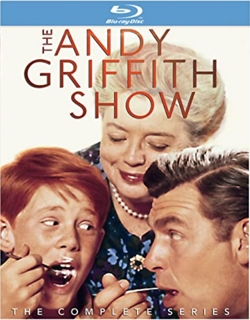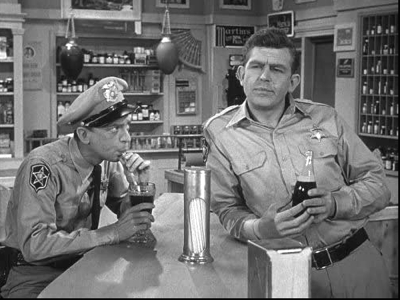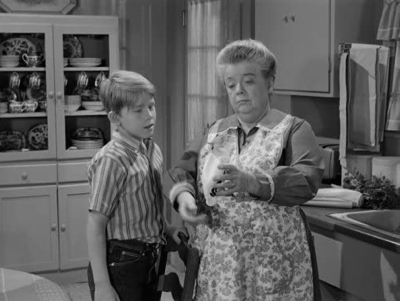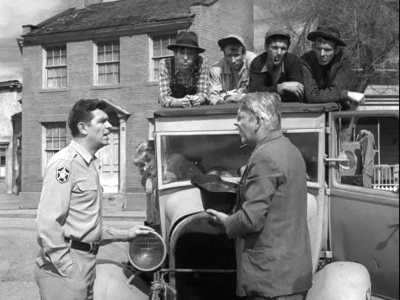Grade: B+/A-
TV comedy
Not rated (would be PG)
It’s hard to believe people ever lived slower lives—especially at a time when folks can’t seem to spend a single moment without multitasking or yakking on cell phones in walk-and-talks that, despite their content (“I’m on my way to the grocery store now”), are conducted with West Wing importance. If you need a refresher course in slowing down, watch The Andy Griffith Show.
If Frank Capra had worked in television, I’m guessing he would have produced something along the lines of this folksy, feel-good, homespun situation comedy that offered an idealized portrait of small-town life. Never once during its eight-season run did the series finish outside the Nielsen Top 10, and its final season the show ended as the No. 1 watched show in America. I Love Lucy and Seinfeld were the only other shows to accomplish that feat.
The series, which ran on CBS from 1960-68, was ranked No. 9 on TV Guide’s list of 50 Greatest TV Shows of All Time. One thing that contributed to the show’s success was that it appealed to both rural and (sub)urban people, and white-collar as well as blue-collar workers. The writing was much sharper than other rural comedies that aired on television before or after it, and the aw-shucks sheriff without a gun solved problems with common sense and wit that was broadly entertaining.
The Town of Mayberry, North Carolina was a sleepy little backwater where Sheriff and Justice of the Peace Andy Taylor (Griffith) doesn’t drink, refrains from using harsh language, and seldom raises his voice. Before The Cosby Show got all sorts of love for modeling a kinder, gentler parenting style, the widowed Sheriff Taylor was showing an earlier generation a better way to raise kids and relate to people. With an aw-shucks demeanor, a bushel full of aphorisms, and a smile that could disarm all but the most hardened criminals, Andy spent much of his time dispensing common-sense advice to family, friends, residents, visitors, and yes, sometimes even criminals.
The writing for this character-driven comedy also featured some very funny lines, and a killer ensemble cast delivered them with verve. When you saw bumbling Deputy Sheriff Barney Fife (Don Knotts) and Floyd the Barber (Howard McNear) week after week, it was almost like living in a small town. You felt as if you knew them, and the show had a comfortable feel to it. Andy’s son, Opie, is played to perfection by a very young Ron Howard, while Aunt Bee (Frances Bavier) is introduced in the first episode as the one who raised Andy and will now do the same with Opie. Fans of Father Knows Best were treated to Elinor Donahue (“Princess” from that earlier TV series) as a druggist and possible love interest for Andy in a five-episode arc.
This first season Griffith played Sheriff Taylor more folksy than he would in later years, and more than a few episodes ended with him sitting on the front porch with his guitar, serenading his “kinfolks.” In one classic episode, a state police task force uses the sheriff’s office as headquarters for an operation to catch an escaped convict, and they exclude Andy and Barney. But Andy plays a hunch and he and Barney end up catching the fellow, with the help of Andy’s leaky rowboat. Of course, the state officer in charge changes his tune about Andy and small town “sheriffin’.” That pattern would repeat itself with fun variations over the next seven years.
It’s tobacco country, so there’s occasional smoking, and fictional Mayberry is in the foothills of Appalachia, so there are poor folks who are accustomed to making their own liquor, no matter what the law says. But to underscore how relatively innocent it all is, in an episode titled “Alcohol and Old Lace” Barney and Andy follow a moonshine trail that leads them straight to a pair of sweet little old ladies. Meanwhile, town drunk Otis lets himself in and out of the jail, and Andy treats him as he is: a friendly neighbor who happens to have a problem with alcohol. Over time, even Otis becomes more than a town drunk, and viewers begin to embrace him as much as the other characters in this endearing ensemble.
For the first several seasons the producers clearly tried to give the show a boost by featuring a string of guest stars that included Bill Bixby (The Incredible Hulk), Buddy Ebsen (The Beverly Hillbillies), Barbara Eden (I Dream of Jeannie), Alan Hale Jr. (Gilligan’s Island), Edgar Buchanan (Petticoat Junction), and Arte Johnson (Laugh-In). They were interesting, but in truth unnecessary. Fans would have kept tuning in regardless, just to see the Mayberry regulars.
After two solid seasons, CBS added more Mayberry characters, among them dim-witted mechanical wizard Gomer Pyle (Jim Nabors), schoolteacher/love interest Helen Crump (Aneta Corsaut), the rowdy, bluegrass-playing Darlings (real-life bluegrass band The Dillards), and rock-throwing, poetry-spouting nut-case Ernest T. Bass (Howard Morris).
The 249 half-hour episodes (plus a faux pilot episode of Andy on The Danny Thomas Show and Opie on Gomer Pyle: USMC) are on 32 discs, with each season having it’s own Blu-ray case and a slipcase holding them all together. The first five seasons aired in black-and-white, and that’s how they’re presented here. The introduction of color coincided with Knotts’ departure, so it felt like an attempt to compensate fans for the loss of the three-time Emmy winner. As if to reinforce how much he meant to the series, Knotts earned two more Emmys for a pair of guest appearances that he made, bringing his total—and the show’s—to five.
This show would easily have been an A-/B+ had Knotts stayed and had Nabors not left the show to star in his own spin-off, replaced by a game George Lindsay as Goober, not nearly as interesting a character as Gomer. But the series had a knack of elevating minor characters so that they had the kind of depth that made people care about them, and that helped the show continue to evolve and stay relatively fresh over the years.
For fans, it will be a real pleasure to pop in a disc and sit back and watch 6-9 episodes per disk, plus eclectic bonus features that include behind-the-scenes clips, the Howards’ home movies on the set, opening clips, and original sponsor ads. Blu-ray is a visible improvement over the DVDs, and can be enjoyed even when streaming signals or Internet connections are spotty. I have only two complaints, and they have nothing to do with the show or quality of presentation. One is that the boxed set includes no master list of episodes or any annotated descriptions. All we get are lists of hard-to-read titles on the discs themselves. That’s it. My other complaint is that the plastic “pages” that hold each disc have pretty flimsy points of attachment. When my set arrived, at least two discs from each season case were loose. When you pay over $100 for a set, you expect better. Paramount/CBS, are you listening?
When you watch these episodes you’ll see so many that you don’t remember, simply because relatively few of the episodes are shown on TV in rerun. It’s like discovering the show all over again.
Entire family: Yes
Run time: 6343 min. (249 episodes, 105.7 hours), Black-and-white (Seasons 1-5) / Color (Seasons 6-8)
Studio/Distributor: CBS Home Entertainment
Aspect ratio: 1.37:1
Featured audio: LPCM 2.0 (Season 1) / DTS-HDMA 2.0 (Seasons 2-8)
Bonus features: B+
Not rated (would be G or PG for adult drinking and smoking)
Language: 1/10—Only occasional sanitized versions, like “dad gum it”
Sex: 1/10—Wholesome as can be, though there is a bathing suit contest in one episode
Violence: 1/10—Some “wrasslin’” and scufflin’, some black eyes, but the actual violence is mostly off-screen, just as guns are pulled but fired only occasionally
Adult situations: 2/10—Some adult smoking, drinking, and drunkenness
Takeaway: This complete set came on the heels of the Blu-ray release of The Andy Griffith Show: Season 1; while those who bought that set might think they wasted their money, savvy classic TV fans know that when a studio tests the waters, if fans don’t respond there might not be another Blu-ray release






Leave a comment